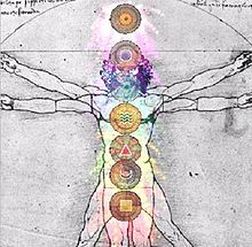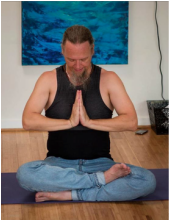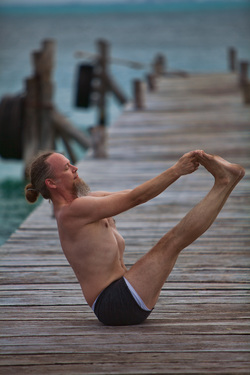
Containment, pretty easy to break down. Con - with; tain from tenere - to hold; ment - the state of. Thus, containment is to be "in the state of holding", or "being held". We know that in words, what is it like to experience that in our asana practice.
I have suggested in yesterday's post that there is an elegant, interdependent series of 'containments' in the asana practice. Pranayama, breath control, is like the 'envelope' into which all else fits. The 'envelope' of pranayama holds the 'love letter' of the asanas practice. Within that 'love letter', there is a story composed of 'words' or asanas. Those asanas in their own right are the vessels for experience, much the same way a kind word lightens our load, and a well-placed bit of nastiness in our tongue cuts as sharp as a knife.
In the asanas, we have experiences; I think it's safe to make that statement. All kinds of experiences, 'good' and 'bad', bidden and unwanted. Experiences that are of us, within us, with us, and often times, at our own hand and by our own creation, as unpleasant as that is to admit. We process these, using the breath and it's ebb and flow to release the stressful elements of tension we encounter. We may or may not understand how pranayama and asana create this internal landscape, but we know they allow us to process.
Physiologically, one of the functions of the mindful breath is to soothe the nervous system. By calming the nervous system and bringing our glandular system back into a healthy level of activity, this enables us to transcend the limbic brain and begin to move to 'executive function' - or higher decision making processes. Amongst all of the processes that executive function support, is the one I like to call discernment.
How this applies to our day to day experience can be approached through yogic anatomy via the Chakras, or through behaviorism via Maslow's "hierarchy of needs"; they support and mirror one another. That's one of the lovely things about brain science; discoveries are made on an ongoing basis that uphold some of the most basic premises of the asana practice and yoga practices in general.
We know that when a human being is trapped in survivalism, in being hyper-vigiliant to their own security and needs - not having the 'root' of Muladhara, or in Maslow, basic security of safety, shelter and food - this leads to a near total shutdown of the pre-frontal cortex and any higher thinking and processing. This leaves that person operating almost completely instinctually from the limbic system - fright, fight, flight... Addressing disproportionality and basic human rights and needs is another topic, but suffice to say in this example, we're talking about jacked up brain chemistry that leads to poor decision making.
One immediate, accessible and universal method of slowing down and correcting this detrimental neurohemical response is mindfulness - which is a really comfortable word for pranayama - directed breath control or mindfulness on the breath. A simple breathing practice that is at the base of yoga, mindfulness, meditation - all of it.
In addition to helping us achieve the higher functioning states - turning on and refining 'executive function' or as I say, simply making better decisions, we can apply this to our practice. To use the pranayama as the access point to the asana practice; to use the asana practice as an investigation into the Self, and to carefully guide and grow the being we are through the interlaced practice of breath and asana. Moving into higher function, higher purpose, more deep discovery and discernment.
Here's how it was taught to me - if this works for you, take it into your practice and grow with it, or teach it in your own way. I'm working with this, inside my practice and through my teachings. Enjoy...
Pranayama is the edge detector of the practice; if we can remain in sama vritti and not yield to a disturbed mind, we can find that union, the communion, our own yoga. If we too desperately seek the sensation in the asana - go for the 'deeper expression' and begin to pant and lose our control - then we are not in union. Likewise, if we simply go through the motions but don't truly engage and rub up against the edge, the resistance, then we might be getting a good stretch, but no real work toward the yoga.
The most delicate balance, the most detached engagement, for the purpose of purposefulness, not achievement. Right at the edge, where asana and pranayama consume the 'citti vritti' - the fluctuating mind - and give it temporary cessation and absorption. A noble goal: our bodies are vessels for our spirit - that which animates us. Asana is where we experience self, pranayama is where we meet Self.
GIve thanks and praise!



